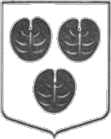 Visite
Leiden in the Golden Century
In the Golden century (17th century)
Visite
Leiden in the Golden Century
In the Golden century (17th century)
the inner-city of Leiden is the second
biggest
town in the Netherlands. Within the canals
(grachten) lived the second largest
population of the United Provinces.
Amsterdam was the center of world trade.
But Leiden had the biggest industriecomplex
of Holland.
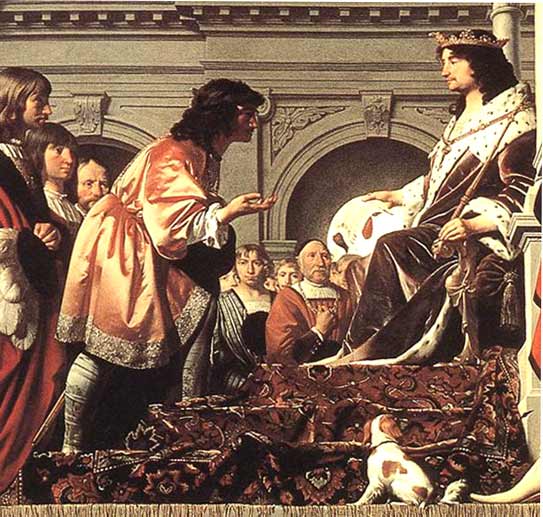
|
Many people were rich in Holland
in the period between 1600 and 1700. Haarlem was het center of art in Holland.
But in Leiden also lived many artists. We give you on this page a impression
in pictures.
Left: Caesar van Everdingen
(born 1617 in Alkmaar, died in 1678 in Haarlem) painted ``Count Willem
II (circa 1250) of Holland granting privileges``
1654 Oil on canvas,
220 x 200 cm
See
Gemeenlandshuis in Leiden
Industrytowns in 1650:
1. Leiden
2. Haarlem
3. Amsterdam (largest harbour)
Leiden today counts only about
117.000 men and women.
The population in1650 was already
60.000. So Leiden was a ``top-ten city`` on the Euro scale.
(In
1690 70.000;
1720 65.000;
1732 60.000) |
|
|
The name Leiden was not very
populair everywhere. Jan of Leiden and many people with him in `his` Anabaptist
Kingdom in Münster (Germany) abolished private property and abolished
monogamy. That was in 1535.
The dutch people nowaday still speak
about ``je er met een Jantje-van-Leiden af maken``, which means you do
your work too quick and very bad. |

|
William
Lord Fitzwilliam - june 1663
From Haarlem we went by water
to Leiden,
the chiefest and biggest
town, excepting Amsterdam, of Holland,
lying as it were in the heart
of it amongst very pleasant meadows;
the river Rhine runs by it.
Here is one of the most famous universities of Europe, not so much
foir colleges (wherewith Oxford and Cambrigde abound), but by reason of
its diligent and learned professirs of all sort of sciences and their method
of teaching young youth.
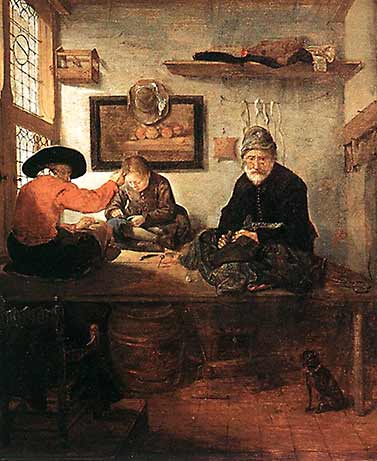 Quiringh van Brekelenkam (1647
Leiden - 1668 Leiden)
painted a taylor in 1653.
Quiringh van Brekelenkam (1647
Leiden - 1668 Leiden)
painted a taylor in 1653.
|
The founder of it was William, Prince
of Nassau, anno februari 1575. The foundation was according to this following
manner.
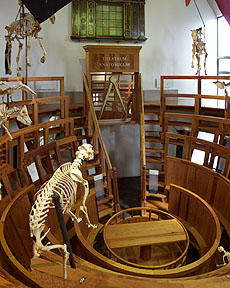 The people came all down to the town
house, a woman in white did ride before in a waggon, holding a bible in
her right hand, being accompanied by the four Evangelists; this did signify
Theology. Aftewards followed Jurisprudentia, riding a unicorn, clad like
Justice used to be painted. She was acompanied by Julianus, Papinianus,
Ulpianus and Tribonianus, the chiefest authors of the law.
The people came all down to the town
house, a woman in white did ride before in a waggon, holding a bible in
her right hand, being accompanied by the four Evangelists; this did signify
Theology. Aftewards followed Jurisprudentia, riding a unicorn, clad like
Justice used to be painted. She was acompanied by Julianus, Papinianus,
Ulpianus and Tribonianus, the chiefest authors of the law.
The university was founded here because
the town did so valiantly hold out against the Spaniards and did rather
choose to eat rats, cats or any other thing than to render itself to the
cruel Duke of Alva. |
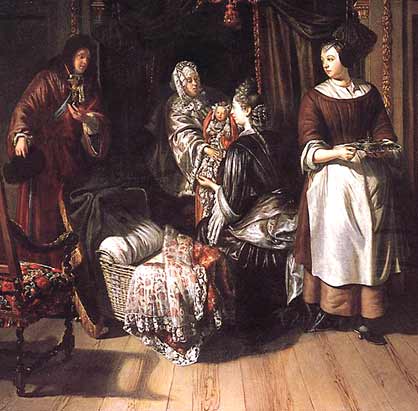 Matthijs Naiveu (1647-1726)
painted Visit to the Nursery in Leiden.
Matthijs Naiveu (1647-1726)
painted Visit to the Nursery in Leiden.
|
The money which they did use in
the time of the siege in 1574 was of paper woth this inscription on it:
Pugno pro patria (I fight for my country), it is yet to be seen in the
Anatomy school.
Anatomy School
Here is a pretty little library
but the Anatomy School is very famous and excellent. I do not think there
is ane ons like it in Europe; it is full of all sort of rarities. Here
you will see the anatomy and skeleton of any animal, European, Asiatic,
African of American, some rare mummies of embalmed bodies of a King and
Queen of Egypt. Here are many idols and strange fashioned clothers and
weapons, all sort of minerals and strange coins, many other rarities, which
may better be seen than be written. Here we found these following verses
made upon the praise of a salt herring.
The college where the university
is, is but little. The public schools are yet big enough. Upon the steeple
of this college we saw a curiosity in optics: things without (outside),
represented within a dark chamber which has but one little hole, where
the light comes in. Here is likewise a great quadrant to be seen. |
| Below, within the limits of the
college, There is the physic (botanical) garden, which is full of all sort
of plants, shrubs and trees. For them that connot endure the cold winter
climate of Holland is heated a long gallery on purpose for to keep and
preserve them. By this garden is likwise a chamber of rarities, of which
some are in the Anatomy School.
In this town the Prince of Orange
has a palace, a very mean one (Prinsenhof). Here is likewise a castle,
called the Burg, built, as some say, by the Romans, but others (which is
more like) by Hengist, a Saxon King after his conquest of Engeland. His
place lies on an artificial hill, very pleasant. Within there is a labyrinth
and a very deep well and the going up to it is very pleasant.
The town house is a pretty building,
but will be much handsomer within a short time. |
Here is a good clock to be seen
and within the house many precious pictures, chiefly them of Cornelis Engelbert`s
(Engelbrechtsz) and Lucas of Leiden`s making. Here is likewise a very great
Dool (Doelen) of shooting house and yard, three or four churches of which
St Peter`s is the chiefest, all full of epitaphs.
Here are likewise many hospitals
and pious houses, several fair streets as the Brede Street (Breestraat)
and the Rapenburg, a great fish marketplace. For the houses, there are
a good store of great houses, all the rest well and uniformly built.
This town is likewise surrounded
with good strong walls and deep ditches but chiefly with very pleasant
walks, set with treed; and a very long and well-made pall-mall is not far
from the gates of this town; and this is all that I did observe in Leiden. |
|
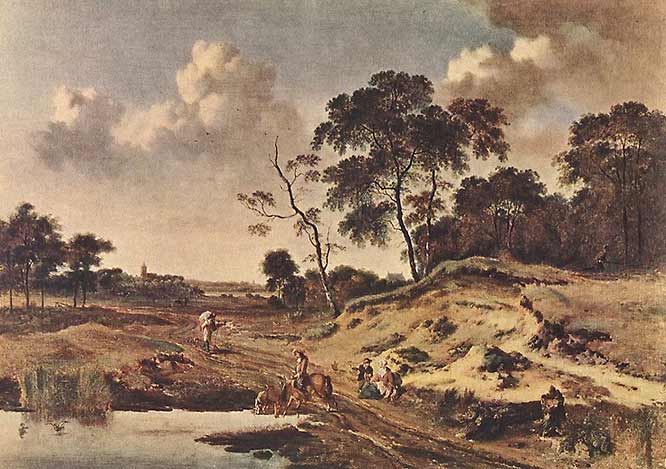
|
| Jan Wynants (born 1630 in
Haarlem, died 1684 in Amsterdam) painted a Landscape with Dune. |
| Thomas Penson July 1687
The next place we designed for was
Leiden, to which we repaired by the next opportunity, whereat we arrived,
went straight to the Academy to see those rarities which remain there.
So soon as we entered the place, each person had a book given into his
hand, printed in English, containing an account of each particular thing
and the marks of the distinct places and presses wherein they were. Here
I beheld the wonderful works of our Great Creator, composed and set together
by the art of man.
At my first approach I was struck
with an awful admiration, almost questioning with in myself whether I was
should dare to go in of not. For as in a wood we behold trees in great
numbers stand confusedly together, so here appeared (as it were) an army
of the bones of dead men, women and children, which seemed so to stare
and grin at us, as if they would instantly make us such as themselves.
And because I would render his eminent
collection worthy the observation of any ingenious person who travels that
wasy I shall here insert some of the particulairs, the skeleton of a French
nobleman, who ravished his sister and afterwards murdered her; the skeleton
of an ass, upon which sits that of a woman who killed her daughter; the
skeleton of a woman of seventeen years old who murderd her son; the skeleton
of a sheep stealer of Haarlem. (...) The skeleton of a man on horseback.
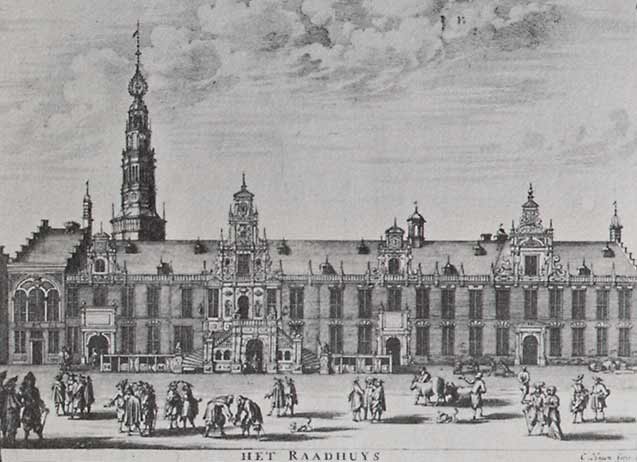
|
|
Christian van Hagen made this
engraving in 1670
|
And as if those were not terrible enough
to fill up this frightful scene, there also appears in the crowd the skeletons
of two bears, the skeleton of a wolf... We afterwards took a short view
of Leiden, which is a place very pleasant, then we rested and refreshed.
And about eleven of the clock at night, the scuyt being ready to go off
and some of our company having urgent business at Amsterdam, myself, als
having letters to deliver there, went with them all night (having for two
stuyvers a cushion to lay my head on) so about six in the morning we arrived
safe at the famous city of Amsterdam.
John Farrington 13-16 september
1710
We came tot Leiden at about eight
o`clock that evening, where we got an entrance by paying sixpence for the
waggon and a penny apiece for ourselves to the porter at the gate, which
is alway done after the gates are shut, which is as soon as it gows duskish.
The first place that we saw was the Anatomy Theater which is just behind
the English church. (...) The next place we saw was the stadhuys where
the burgomasters meet, there is a very curious picture of the Resurrection
(Last Judgement made in 1526), done by Lucas van Leyden, of an immense
value. Over the chemney of the samen room is a fine piece of Liberty of
Freedom, where is an empress who is said to have desired the goverment
of the empire only for twentyfour hours, in which time she took occasion
to cut off her husband`s head. |
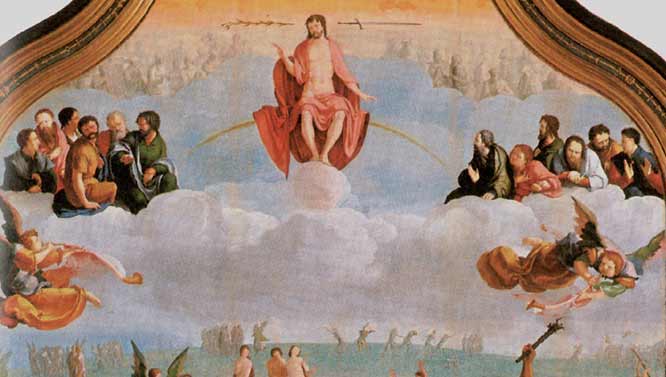
|
| Under the stadsthuys is the Flesh
Hall where all the meat must be sold. There is a considerable quantity
of flesh in that hall, but nothing comparable to the least of our markets
in London. But such is the regularity of the Dutch government, all meat
must be sold here, and inspected by proper officers, that no rotten of
meanly meat may be sold to the ignorant or foolish buyer. But the principal
glory of this town is its University which was founded by the prince of
Orange in the year 1575 on this occasion. When the Spaniards had overrun
almost all Holland, Leiden was straitly besieged by them and reduces to
the last extremity by famine, and the usual consequence of that, a great
mortality, so that the inhabitants mutinying winthin and the enemy pressing
from wothout, the town was on the point of surrender, and had done it.
Only one of the burgomasters withstood it at the hazard of his life.
But the Prince of Orange cutting
the banks, and coming in boats over the lands with a supply of provicions,
and a part of the wall falling down, which the Spaniards looked upon as
done with a design to sally out upon them, though said to be merely casual,
struck so great terror into them, that they immediately fled in the utmost
disorder, and the town retrieved, and Holland saved from ravage and destruction,
which would have followed the taking of that town. For the brave defence
they had made for their country`s liberty, and the hazard to which they
had exposed themselves, the Prince offered them either to give them so
many years immunity from taxes, or to found an university with several
privileges annexed to it, which latter the inhabitants wisely chose as
like to be of advantage not only for a term of years, but for perpetuity. There are in this university sixteen
professors, besides praelectors, four in divinity, law and physic (medicine)
and two in languages, two in oratory. The privileges which this university
enjoys, and the honourableness of the station, draw both the most valuable
professors from other universities and a great number of scholars hither. Leiden is very large and ancient,
the second biggest in Holland. Without the fortifications which are no
other than a broad and deep ditch and a wall with some bastions, is a very
good cingle or walk regularly planted with lime trees on each side. Their religion is Calvinist only
there is an unlimited toleration. There are four large Dutch churches;
the principal is St Peter`s, one English, one German or Lutheran Church,
one French and one Minist (Mennonite) or Baptist congregation, besides
a great number of Popish chapels. |
Hofje
The trade of this town is chiefly
the woollen manufactory, but since the war with France (1702 - 1714), their
trade is dead and the town much improverished. The chief buildings are
the stadthouse, churchs, university, cloth hall, which is the samen with
them as Blackwell Hall is with us. And the hofjes, or courts where the
poor live, which are about twentyfive in number. These have eight of ten
or some of them more apartments with little gardens to them and are mighty
pleasant and convenient as well as a great advantage to the poor of this
city.
I should have told you that the music
of the chimes which consist of between thirty and forty bells, is very
agreeable and that the organs in the great church are mighty harmonious,
and as played upon three evenings in a week, afford the inhabitants a great
deal of diversion. But our chaises are ready and I must lose no time, therefore
I conclude thus abruptly, only, Sir, have stille time to assure you that
I am your very humble servant. See also: In
de voetsporen van Van Tetrode Leiden |
|
Next
and last page
|








